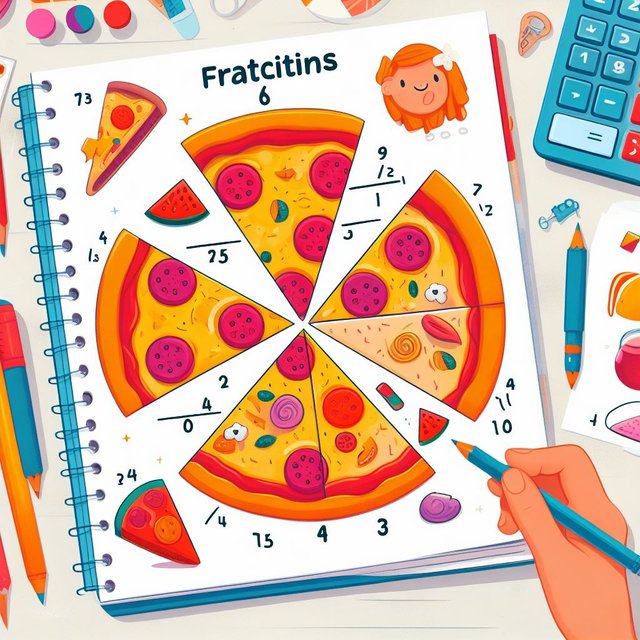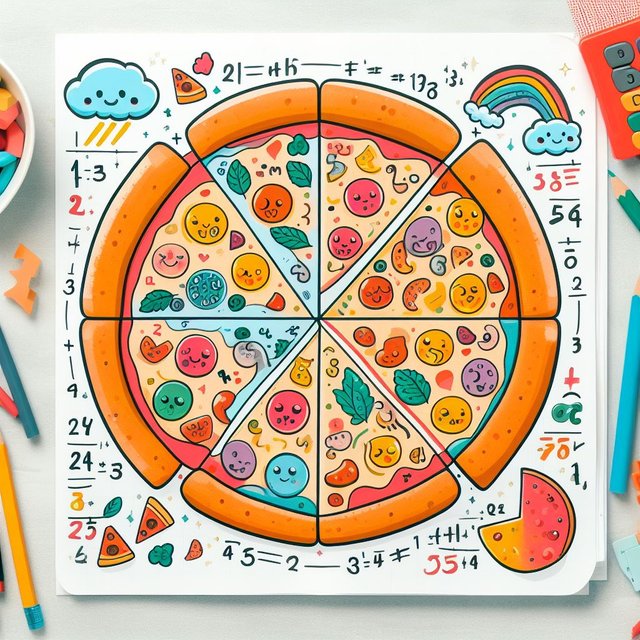Introduction to Fractions

Fractions represent parts of a whole. In the fraction a/b, a is the numerator (the parts we have), and b is the denominator (the total parts that make up the whole).
Example 1: If you have 3 slices out of 8 slices of pizza, it can be represented as 3/8.
Example 2: When you eat 3 out of 6 equal slices of cake, it's 3/6.
Example 3: Consider the list of individuals: @dobartim, @fuli, @steemitblog, @malikusman1, @bluesniper, @solaymann, @steem4nigeria, @filinpaul, and @drhira. If you want to express the number of a specified individual out of the total number, you can use the fraction:
1/9.
This fraction represents the number of specified individuals out of the total number of individuals in the list.
Think of daily life examples where you encounter fractions—sharing chocolates, dividing oranges, or using measurements in recipes. Understanding fractions helps simplify these tasks.
Numerator and Denominator
In a fraction a/b, a is the numerator, representing the number of parts considered, and b is the denominator, representing the total number of equal parts that make up the whole.
For instance:
In the fraction 3/4, 3 is the numerator, indicating we have 3 parts.
In 5/6, 5 is the numerator, representing 5 parts.
In 1/2, 1 is the numerator, indicating 1 part out of 2 equal parts.
Types of Fractions:
a. Proper Fractions: These are fractions where the numerator is less than the denominator. For example, 1/2, 3/4, and 2/5 are all proper fractions.
b. Improper Fractions: These are fractions where the numerator is greater than or equal to the denominator. For instance, 5/4, 7/3, and 11/5 are all improper fractions.
c. Mixed Numbers: A mixed number is a combination of a whole number and a proper fraction. For example, 1 1/2, 2 3/4, and 3 2/5 are all mixed numbers.
Equivalent Fractions:
Equivalent fractions are different fractions that represent the same value. They have different numerators and denominators but the same overall value.
For example:
1/2 is equivalent to 2/4 because both represent half of a whole.
2/3 is equivalent to 4/6 because both represent two-thirds of a whole.
Addition and Subtraction of Fractions:
a. Adding Fractions with Like Denominators: To add fractions with the same denominators, simply add the numerators and keep the denominator the same. For example, to add 1/3 and 2/3, we get 3/3, which simplifies to 1 whole.
b. Adding Fractions with Unlike Denominators: To add fractions with different denominators, find the least common denominator (LCD), convert each fraction to an equivalent fraction with the LCD, add the numerators, and retain the LCD as the denominator.
c. Subtracting Fractions: Subtracting fractions follows a similar process. When subtracting fractions with like or unlike denominators, adjust the fractions to have the same denominators before subtracting.
Multiplication and Division of Fractions:
a. Multiplying Fractions: To multiply fractions, multiply the numerators together and the denominators together. For example, 1/2 3/4 = 3/8.
b. Dividing Fractions: To divide fractions, multiply the first fraction by the reciprocal of the second. For example, (2/3) ÷ (4/5) = (2/3) (5/4) = 10/12.

Real-Life Applications of Fractions:
Understanding how fractions apply to real-life situations is essential. Some common scenarios include:
Cooking: Using fractions when measuring ingredients for recipes, such as 1/2 cup of flour or 1/4 teaspoon of salt.
Measurement: Using fractions when measuring lengths, such as 3/4 of an inch or 1/2 of a foot.
Sharing Quantities: Using fractions to divide quantities equally, such as sharing 1/3 of a pizza among three friends.
Fractional Operations with Whole Numbers:
Performing operations involving fractions and whole numbers is crucial. Here are some examples:
Addition and Subtraction: Adding or subtracting a whole number and a fraction, such as 2 + 1/3 or 5 - 3/4.
Multiplication and Division: Multiplying or dividing a whole number by a fraction, such as 4 2/3 or 6 ÷ 1/2.
Understanding how to combine fractions and whole numbers is important in practical applications.
Test Questions
- What is the numerator and denominator in the fraction 4/7?
- Classify the fraction 5/2 as a proper, improper, or mixed number.
- Provide an example of an equivalent fraction for 2/3.
- Calculate the sum of 1/4 and 2/4.
- Subtract 1/3 from 2/3.
- Multiply 1/2 by 3/4.
- Divide 2/3 by 4/5.
- Divide 3 by 1/2.
- Add 2 to 1/3.
- Subtract 1/4 from 2.
- Convert the mixed number 3 1/2 to an improper fraction.
- Find an equivalent fraction for 3/5 with a denominator of 15.
- Solve the problem: If you eat 2/3 of a cake and your friend eats 1/3, how much of the cake is left?
- A recipe calls for 3/4 cup of sugar. If you want to make half the recipe, how much sugar do you need?
- Divide 4 by 3/4.
- Simplify the fraction 8/12 to its lowest terms.
- Add 1/5 and 2/3.
- What is the result of 2/5 multiplied by 5/6?
- Solve the equation 3/4 + x = 1, for x.
- Subtract 1 1/2 from 3.